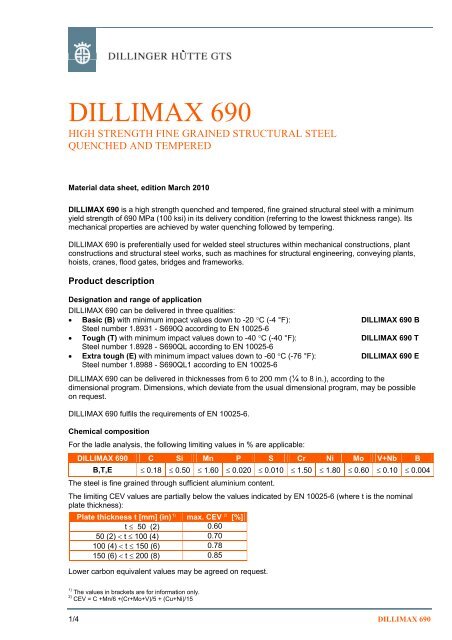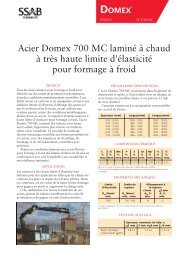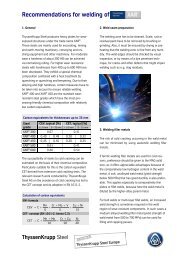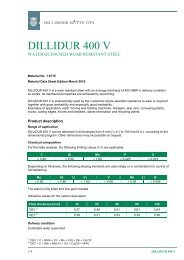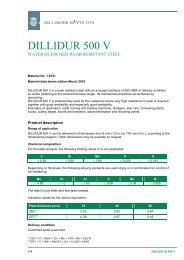Dillimax 690 T - High Strength Plates & Profiles Inc.
Dillimax 690 T - High Strength Plates & Profiles Inc.
Dillimax 690 T - High Strength Plates & Profiles Inc.
Create successful ePaper yourself
Turn your PDF publications into a flip-book with our unique Google optimized e-Paper software.
DILLIMAX <strong>690</strong><br />
HIGH STRENGTH FINE GRAINED STRUCTURAL STEEL<br />
QUENCHED AND TEMPERED<br />
Material data sheet, edition March 2010<br />
DILLIMAX <strong>690</strong> is a high strength quenched and tempered, fine grained structural steel with a minimum<br />
yield strength of <strong>690</strong> MPa (100 ksi) in its delivery condition (referring to the lowest thickness range). Its<br />
mechanical properties are achieved by water quenching followed by tempering.<br />
DILLIMAX <strong>690</strong> is preferentially used for welded steel structures within mechanical constructions, plant<br />
constructions and structural steel works, such as machines for structural engineering, conveying plants,<br />
hoists, cranes, flood gates, bridges and frameworks.<br />
Product description<br />
Designation and range of application<br />
DILLIMAX <strong>690</strong> can be delivered in three qualities:<br />
• Basic (B) with minimum impact values down to -20 °C (-4 °F): DILLIMAX <strong>690</strong> B<br />
Steel number 1.8931 - S<strong>690</strong>Q according to EN 10025-6<br />
• Tough (T) with minimum impact values down to -40 °C (-40 °F): DILLIMAX <strong>690</strong> T<br />
Steel number 1.8928 - S<strong>690</strong>QL according to EN 10025-6<br />
• Extra tough (E) with minimum impact values down to -60 °C (-76 °F): DILLIMAX <strong>690</strong> E<br />
Steel number 1.8988 - S<strong>690</strong>QL1 according to EN 10025-6<br />
DILLIMAX <strong>690</strong> can be delivered in thicknesses from 6 to 200 mm (¼ to 8 in.), according to the<br />
dimensional program. Dimensions, which deviate from the usual dimensional program, may be possible<br />
on request.<br />
DILLIMAX <strong>690</strong> fulfils the requirements of EN 10025-6.<br />
Chemical composition<br />
For the ladle analysis, the following limiting values in % are applicable:<br />
DILLIMAX <strong>690</strong> C Si Mn P S Cr Ni Mo V+Nb B<br />
B,T,E ≤ 0.18 ≤ 0.50 ≤ 1.60 ≤ 0.020 ≤ 0.010 ≤ 1.50 ≤ 1.80 ≤ 0.60 ≤ 0.10 ≤ 0.004<br />
The steel is fine grained through sufficient aluminium content.<br />
The limiting CEV values are partially below the values indicated by EN 10025-6 (where t is the nominal<br />
plate thickness):<br />
Plate thickness t [mm] (in) 1) max. CEV 2) [%]<br />
t ≤ 50 (2) 0.60<br />
50 (2) < t ≤ 100 (4) 0.70<br />
100 (4) < t ≤ 150 (6) 0.78<br />
150 (6) < t ≤ 200 (8) 0.85<br />
Lower carbon equivalent values may be agreed on request.<br />
1) The values in brackets are for information only.<br />
2) CEV = C +Mn/6 +(Cr+Mo+V)/5 + (Cu+Ni)/15<br />
1/4 DILLIMAX <strong>690</strong>
Delivery condition<br />
Water quenched and tempered according to EN 10025-6.<br />
Mechanical and technological properties in the delivery condition<br />
Tensile test at ambient temperature - transverse test specimens -<br />
Plate thickness t [mm] (in.) 1)<br />
> 65 (2.5)<br />
> 100 (4)<br />
> 150 (6)<br />
≤ 65 (2.5)<br />
≤ 100 (4)<br />
≤ 150 (6)<br />
≤ 200 (8)<br />
Impact test on Charpy-V-specimens<br />
DILLIMAX <strong>690</strong> Specimen direction<br />
Tensile strength<br />
R m [MPa] (ksi) 1)<br />
770 - 940 (112 - 136)<br />
770 - 940 (112 - 136)<br />
720 - 900 (104 - 130) 4)<br />
700 - 880 (100 - 127) 4)<br />
Minimum yield strength<br />
R eH 2) [MPa] (ksi) 1)<br />
<strong>690</strong> (100)<br />
670 (97) 4)<br />
630 (91) 4)<br />
610 (88) 4)<br />
Minimum elongation<br />
A 5 [%] A2in. 3) [%]<br />
2/4 DILLIMAX <strong>690</strong><br />
14<br />
14<br />
14<br />
14<br />
Impact energy A v [J] (ft.-lb.) 1) at test temperature<br />
0 °C (32 °F) 1) -20 °C (-4 °F) 1) -40 °C(-40 °F) 1)<br />
15<br />
15<br />
15<br />
15<br />
-60 °C (-76 °F) 1)<br />
Basic (B) longitudinal / transverse 40/30 (30/22) 30/27 (22/20) − −<br />
<strong>High</strong> toughness (T) longitudinal / transverse 50/35 (37/26) 40/30 (30/22) 30/27 (22/20) −<br />
Extra tough (E) longitudinal / transverse 60/40 (44/30) 50/35 (37/26) 40/30 (30/22) 30/27 (22/20)<br />
The specified minimum value is the average of 3 tests. Only one individual value is permitted to be below this minimum value, and<br />
no more than 30%. For plate thicknesses below 12 mm the test can be carried out on Charpy-V test specimens with reduced width;<br />
the minimum width must be 5 mm. The minimum impact value will be decreased proportionally.<br />
Testing<br />
Tensile and impact tests will be performed according to EN 10025-6 once per heat and 40 t. Tests on<br />
every heat treated plate may be possible on request.<br />
The specimens for the tensile test are prepared according to EN 10025-6. Testing is carried out on<br />
specimens of gauge length L0 = 5.65⋅√S0 or L0 = 5⋅d0, in accordance with EN ISO 6892-1.<br />
Tensile tests according to ASTM A370 may be agreed.<br />
The impact test will be carried out on Charpy-V-specimens in accordance with EN 10045-1. Unless<br />
otherwise agreed, the test will be performed at the lowest temperature of the corresponding quality on<br />
transverse test specimens taken as follows:<br />
• for plate thicknesses < 40 mm: the test specimen shall be taken in such a way that one side is not<br />
further away than 2 mm from a rolled surface.<br />
• for plate thicknesses ≥ 40 mm: ¼ of the plate thickness.<br />
Unless otherwise agreed, the test results are documented in a certificate 3.1 in accordance with<br />
EN 10204.<br />
Identification of plates<br />
Unless otherwise agreed, the marking is carried out via steel stamps with at least the following<br />
information:<br />
• steel grade (e.g. DILLIMAX <strong>690</strong> B, T or E)<br />
• heat number<br />
• number of mother plate and individual plate<br />
• the manufacturer’s symbol<br />
• inspector’s sign<br />
1)<br />
The values in brackets are for information only.<br />
2)<br />
If not apparent, the yield strength Rp0.2 is measured instead.<br />
3)<br />
These values apply if tested according to ASTM A370.<br />
4) <strong>High</strong>er minimum values may be agreed on request.
Processing<br />
The entire processing and application techniques are of fundamental importance to the reliability of<br />
products made from this steel. The user should ensure that his design, construction and processing<br />
methods are aligned with the material, correspond to the state-of-the-art that the fabricator has to comply<br />
with and are suitable for the intended use. The customer is responsible for the selection of the material.<br />
The recommendations of the EN 1011-2 (Welding) and CEN/TR 10347 (Forming) as well as<br />
recommendations regarding job safety in accordance with national rules should be observed.<br />
Cold forming<br />
Cold forming means forming below the maximum allowable stress relief temperature (560 °C/1040 °F).<br />
DILLIMAX <strong>690</strong> can be cold formed with regard to its high yield strength. Flame cut or sheared edges in<br />
the bending area should be ground before cold forming. Cold forming is related to a hardening of the steel<br />
and to a decrease in toughness. Depending on the relevant design code this can result in the need of<br />
larger bending radiuses than indicated in the chart. For larger cold forming amounts we recommend you<br />
to consult the steel producer prior to ordering.<br />
During the processing, the necessary safety measures have to be taken, so that nobody will be exposed<br />
to a danger by a possible fracture of the work piece during the forming process.<br />
The following geometries can usually be achieved by cold forming without the formation of surface<br />
defects (where t is the plate thickness):<br />
Minimum bending radius Minimum die width<br />
Transverse direction 2 t 7 t<br />
Longitudinal direction 3 t 9 t<br />
Hot forming<br />
If the temperature of 560 °C (1040 °F) is exceeded, the initial tempering will be altered so that the<br />
mechanical properties are affected.<br />
To regain the initial properties new quenching and tempering become necessary. However, water<br />
quenching of a formed workpiece or component will often be less effective than the original quenching in<br />
the plate mill so that the fabricator may not be able to reestablish the properties required and therefore<br />
hot forming may not be suitable. In this respect we recommend you to contact the steel producer prior to<br />
ordering, in all cases where hot forming is required.<br />
Finally, it is the fabricator’s responsibility to obtain the required values of the steel through an<br />
appropriate heat treatment.<br />
Welding and flame cutting<br />
Due to its high yield strength, DILLIMAX <strong>690</strong> requires special care during plate processing. Detailed<br />
instructions for flame cutting of the DILLIMAX are provided in the technical information “MAKE SAVINGS<br />
WITH HIGH STRENGTH STEELS - DILLIMAX”.<br />
For general welding instructions, please consult the EN 1011. In order to ensure that the tensile strength<br />
of the weld metal fulfils the requirements of the base metal, the heat input and interpass temperature<br />
must be limited during welding. Experience has shown that the welding conditions should be chosen so<br />
that the cooling time t8/5 does not exceed 20 seconds. This is applicable when using suitable filler<br />
materials of a corresponding yield strength class.<br />
The high yield strength of the base material must be taken into account when choosing the filler materials.<br />
It should be considered that increased heat input leads to lower tensile properties in the weld metal. If a<br />
stress relieving heat treatment is planned during or after plate processing, this must also be considered<br />
when selecting the filler materials.<br />
To avoid hydrogen-induced cold cracking, only filler materials, which add very little hydrogen to the base<br />
metal, may be used. Therefore, shielded arc welding should be preferred. For manual arc welding,<br />
electrodes with basic coating (type HD
Heat treatment<br />
If a stress relieving has to be considered because of constructional regulations, constructive reasons or<br />
because it is necessary for the fabrication, please consult us. The properties of structural components<br />
can be altered by a stress relief heat treatment.<br />
Detailed instructions for flame cutting, welding, machining and about the structural properties of the<br />
DILLIMAX are provided in the technical information “MAKE SAVINGS WITH HIGH STRENGTH STEELS<br />
- DILLIMAX”.<br />
General technical delivery requirements<br />
Unless otherwise agreed, the general technical delivery requirements in accordance with EN 10021<br />
apply.<br />
Tolerances<br />
Unless otherwise agreed, the tolerances will be in accordance with EN 10029, with class A for thickness<br />
and table 4, steel group H, for the maximum flatness deviation. Smaller flatness deviations may be<br />
possible on request prior to order.<br />
Surface quality<br />
Unless otherwise agreed, the specifications will be in accordance with EN 10163-2, class A2.<br />
General note<br />
If particular requirements are demanded and not covered in this data sheet, please contact us with the<br />
specifications for our review and agreement prior to ordering. The information in this data sheet is a<br />
product description. This data sheet is updated at occasion demands. The latest version is available from<br />
the mill or as download at www.dillinger.de.<br />
Distribution<br />
For your local representative<br />
please contact our coordination office in Dillingen:<br />
Telephone: +49 6831 47 22 23<br />
Fax: +49 6831 47 33 50<br />
or the internet:<br />
http://www.dillinger.de/dh/kontakt/weltweit/index.shtml.en<br />
AG der Dillinger Hüttenwerke<br />
Postfach 1580<br />
D-66748 Dillingen/Saar<br />
e-mail: info@dillinger.biz<br />
http://www.dillinger.de<br />
Telephone: +49 6831 47 21 46<br />
Fax: +49 6831 47 30 89<br />
4/4 DILLIMAX <strong>690</strong>


